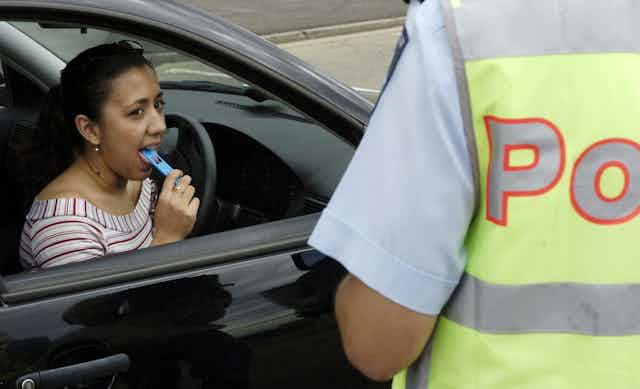This month NSW magistrate David Heilpern dismissed a charge against a driver of driving with an illicit drug present in his body. The magistrate did so on the grounds that the defendant, after an earlier discussion with a police officer, had an “honest and reasonable” belief that he would not still have a detectable level of cannabis nine days after his most recent cannabis use.
Since then, drug-driving legislation, which exists in all states and territories, has been under scrutiny.
With the federal parliament having passed legislation for medicinal cannabis, there’s increasing concern about the potential iniquity of sick, elderly people taking a lawful drug under medical supervision receiving a severe penalty if roadside testing for THC (tetrahydrocannabinol – the main psychoactive substance in cannabis) turns out to be positive. A six-month driving licence suspension would be tough for city dwellers, but a cruel hardship for sick, elderly rural residents.
It’s not yet known whether all or only some medicinal cannabis formulations to be permitted in Australia will contain THC.
The aim of the National Road Safety Strategy is to reduce the number of people killed and seriously injured on our roads. So this should also be the aim of drug-driving legislation.
When states punish their citizens for wrongdoing, the laws must be known to achieve their objectives, punishments must be proportional to the offences, the laws must be fair and just, and must also be based on rigorous science.
Unfortunately, we still do not know if our drug-driving laws improve road safety, but they do not seem to be fair or just. They are certainly not based on robust science. In these ways they differ markedly from our laws on drink-driving, which have been proven to reduce road crashes.
The current drug-driving legislation was introduced without evidence that it would attain road safety objectives (in contrast to the introduction of breath testing for alcohol). It has not been rigorously evaluated to test for possible impacts on road crashes and for unintended adverse consequences.
This is scandalous for legislation introduced a decade ago. NSW is now trebling the annual number of roadside oral fluid tests being conducted to 97,000 by 2017. Other states are also ramping up testing.
Governments need to commission independent research using data from the last ten years to see if drug-driving laws have reduced the number of road crashes, injuries and deaths.
How to make drug-driving laws fair and reasonable
Drug-driving laws and policy need to be seen, by lawyers and the community, to be fair and just. For this to happen, scientific research needs to demonstrate that the drugs selected for testing are major contributors to road crashes.
In other words, the evidence needs to show that a person driving soon after taking drugs has a significantly higher likelihood of a crash than someone who has not taken those drugs, and that the increased risk is caused by the drugs, not by other factors such as speeding or fatigue.
The evidence is clear that some drugs, both legal and illegal, adversely affect driving ability. However, whether or not drugs affect driving is an important question but not the important question. The most important question is whether or not a particular drug, independent of other factors, increases the risk of a road crash, death or serious injury. And, if so, how much of that drug has to be present to cause how much increased risk?
The drugs to be included for testing need to be on the basis of their relative risk, relatively common use and significant contribution to road crashes, but not because of their legal or therapeutic status. This is because some of the legal drugs used therapeutically, such as benzodiazepines like Valium, impair drivers even more than some illegal drugs do.
The amount of the drug in the system also needs to be taken into account. Someone who took an ecstasy tablet a few days ago may still have detectable levels in their system, but will have significantly different levels of impairment to someone who took one an hour ago.
The UK government set up an expert panel that advised the different blood concentration levels for different drugs. Unfortunately, many of the recommendations about what levels of drugs in the body produce unacceptably high risks of road crashes, injuries and deaths were ignored.
As the use of combinations of drugs increases risk, the thresholds of elevated risk need to take into account drivers using more than one drug, especially where the additional drug was alcohol. The risk of a crash occurring when the driver has consumed both alcohol and cannabis is many times that of a driver who has consumed cannabis alone.
Any test of impairment as assessed by police at the roadside needs to be reliable and truly random. Targeted testing carries a considerable risk that vulnerable minorities could be over-represented.
Much of the success of random breath testing for alcohol has been because that testing has been carried out randomly and with high visibility. All drivers felt they were at risk of being tested. This perception of risk of apprehension should also extend to drug-driving.
Punishment for drug-driving also needs to be proportional to the equivalent punishment for drink-driving. It is unfair and unreasonable that, as in the ACT for example, a conviction for having any detectable level of three proscribed drugs in oral fluids results in penalties similar to a blood alcohol level of .08g per 100ml, rather than the .05 level.
Lastly, programs need to be evaluated and be able to demonstrate not only a reduction in road crashes, including a reduction in fatalities and severe injuries, but also a reasonable level of cost-effectiveness and an absence of significant unintended adverse consequences.

